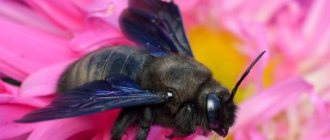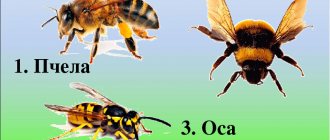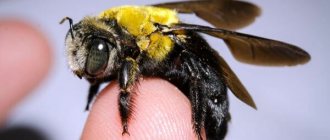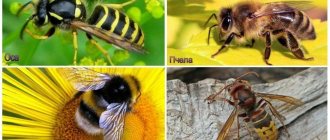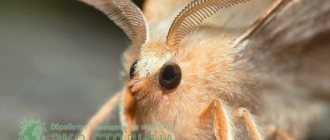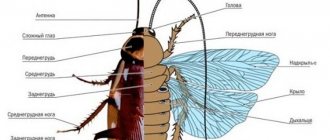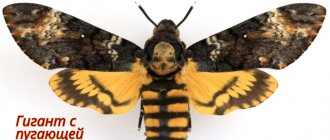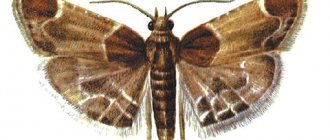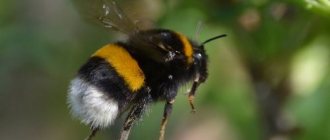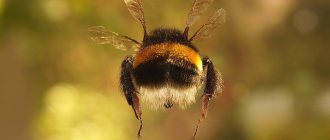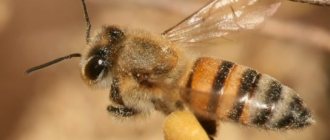Everyone who has constant contact with nature paid attention to large black bees, which could be mistaken for a fly or bumblebee. However, this type of insect is neither one nor the other. Carpenter bees from the Apidae family belong to the species of solitary bees and are endangered, therefore they are listed in the Red Book
The habitat of the carpenter bee (xylocope) extends to the territory of central and western Europe, northern Africa, and in the east to Mongolia, with the exception of northern latitudes. On the territory of Russia, the blue bee is distributed in the Volga region and the Central Black Earth region, the south of the Stavropol and Krasnodar territories, Moscow, Tula, Arkhangelsk, Leningrad and a number of other regions.
The carpenter bee has up to 500 species, which includes not only bees, but also the purple carpenter bee, as well as several names of fossil representatives of the family. However, only the common carpenter bee lives on the territory of Russia, Ukraine, and Belarus.
Features of the black bee
Xylocopa is a bee that grows much larger than a honey bee.
It has a black body with blue wings. The insect settles in the wood of dry trees. If measures are not taken immediately, then within a year there will be a whole colony of them. In addition to old trees, the black bee can settle in the wooden elements of buildings, where it begins to make a tunnel, gnawing along the outer wall, at a distance of two or three centimeters from the edge. In this case, the tunnel can be very long, at least thirty centimeters. Despite the fact that the insect is a bee, it does not produce wax or honey, but it greatly damages wooden structures. These bees are also called carpenter bees; they are solitary insects, the same as mason bees. This species has individuals: male and female. While honeybees have: a worker bee, a drone and a queen. Despite the fact that both types of insects are completely different and do not resemble each other in any way, there is one common property between them - the male does not have a stinger, and therefore does not sting.
Interesting. Considering the characteristics of carpenters, it should be noted that these individuals are not aggressive.
Male black bees do not have a sting and do not sting the enemy; in appearance they are completely indistinguishable from females. Depending on the species (there are more than five hundred of them in the genus Xylocopa), the body can be up to three centimeters long. The insect's abdomen has an unusual black color. In addition, there is absolutely no gun on him.
There are some species that do have hairs that are light brown, green, or yellow-green. For his home, the carpenter chooses soft wood, in which he makes only one entrance, which turns into a tunnel. During the construction of the tunnel, insects do not eat fiber, they simply saw the wood; you can find the entrance by microscopic shavings and sawdust.
Black bee
Important! The black bee does not settle in such wood species as birch, oak, beech and ash. In addition, if a tree grows and develops, then a bee will not settle in it
In this case, she chooses wood for building materials.
Benefits and harms
Why is this beautiful bumblebee dangerous? Male purple carpenter bumblebees lack the ability to sting, although they can pursue intruders into their territory. A female bee can sting, but it will not attack for no reason; in most cases, it will simply fly away when it sees a person. Solitary tree bees as a species are characterized by a low level of aggression, in contrast to honey bees (medium level of aggression), or wasps (high). The black bumblebee is no exception.
The sting of a black carpenter bee is painful and dangerous. Severe pain is felt at the site of the lesion, the skin turns red and swells. Insect venom contains substances that affect the human nervous system, so serious problems are possible for people with neurological diseases. Extremely negative consequences are likely for people suffering from allergies.
Could this bee attack lead to death? A carpenter bee sting to the throat can actually be fatal due to anaphylactic shock. However, the insect is an endangered species and, due to its calm disposition, rarely bites. Therefore, the likelihood of being harmed by a purple carpenter bumblebee is extremely low.
Carpenter bumblebees are sometimes considered pests that damage wooden buildings. But insects never choose fresh, strong wood for their nests. It is beyond their strength, despite their powerful jaws. Carpenters settle only in old wood that has lost a significant portion of its density. Therefore, their settlements can be considered an indicator of the quality of fences or sheds: if a carpenter bee begins to build masonry in them, then it’s time to update the material.
Carpenter bees do not live in painted or treated wood. The purple carpenter bumblebee is an excellent pollinator. In solitary bees this figure is many times higher. They work even in bad weather and are able to cover vast distances in search of food.
What behavior does the black bumblebee have and how does it reproduce?
The black bumblebee differs from other members of the family in its large body size (27 mm). All individuals are assigned to the genus Xylocopa. The insect has a completely black color with the effect of purple reflections. At first glance, it may seem to ordinary people that there is a fly in front of them. Blue bumblebees live solitary lives, never creating large working families under the leadership of an authoritative queen.
- The bee has a fairly calm disposition and will not attack a person passing by. However, the bite force of the black (blue) bumblebee is several times higher than that of an ordinary honey insect.
- The large head with a purple tint is striking in its size, and the blue bumblebee has very powerful jaws. Due to the unique sticky cover of their legs, these creatures collect large amounts of pollen from plants, trees and flowers.
- They were nicknamed carpenters because they prefer to make their homes in the trunks and attics of people’s homes. Capable of chewing long tunnels on the roofs of houses.
- In their nests, insects build special partitions, where, having collected a sufficient amount of pollen, they lay eggs and seal the passages in their homes.
- The larvae of the black (blue) bumblebee mature on their own and, upon hatching, begin to gnaw their way to freedom.
- When this active insect is busy with its activities, a person calmly resting hears a rather loud sound.
We suggest you read: Why is the bumblebee striped for children?
On a note!
The black bumblebee is very rarely found in nature and is listed in the Red Book. The present species inhabits the central and western territories of the Old World.
From May to June, hardworking bees diligently collect nectar from a variety of plants and flowers (white acacia, willow, red clover).
Scientists compare the behavior of a loving pair of bees with the mating behavior of some species of birds. The male individual bravely rises to the surface of an elevated place and for a long time with great courage guards the territory from the encroachments of other males. Future mothers of cubs also try to occupy heights where they will meet a potential partner.
It turns out that in each separate section an embryo develops, and nectar is lovingly and abundantly left around, which will serve as food for the newborn individual. The fathers and mothers of the family, having closed the entrance to the nest, leave it forever.
Varieties of bees
- The common bumblebee is sometimes confused with a wasp, which also has yellow stripes on its body. Bees have a calm disposition and rarely sting humans.
- Honey-bearing specimens are more hardworking, therefore they are in great demand among beekeepers. Brown and golden stripes are visible on their abdomen. Honey bees differ in the specifics of their nutrition and life activity.
- The black bumblebee from the American continent is a productive nectar collector. This specimen is endowed with an active and nervous character, and begins to rush about passionately when the beekeeper opens the hive.
- The German bee has a strong immune system and a calmer disposition. There is a great stratification in the family: some create huge families, others remain hermits.
- An insect from the northern regions of Africa behaves most aggressively in the apiary. The species is famous for its fertility. When keeping insects, beekeepers use personal protective equipment, since the bite of the black bumblebee is quite sensitive.
- Specimens from central Europe are actively engaged in reproduction in autumn and spring. Endowed with strong immunity against popular diseases of the species. If you disturb them, they begin to behave irritably and sternly.
- The black Sicilian bumblebee has a long proboscis and a peaceful nature. They never allow themselves to steal other people's supplies.
On a note!
Science knows a wide variety of black bumblebees. Each species has a unique behavior, coloring and body structure. Beekeepers value those individuals that hardworkingly collect nectar and take it to the apiary, where healing honey is obtained.
Popular varieties of black bees
Highly social bees are considered separately. This group differs not only in behavior and structure, but also in its body structure.
- Ordinary. The insect is very similar in color to a wasp. The black insect is small in size and not aggressive; the wasp is more irritated. Yellow and black stripes can be seen on the body. They build underground passages.
- Honey-bearing. They accumulate a large amount of honey in the honeycombs; they are small in size, black in color, and have brown and yellow stripes on the belly. Beekeepers breed these bees to produce large quantities of honey. Such bees can be different, there are black and white, pure black. They all differ in their feeding habits - they prefer different nectar, and also differ in their lifestyle - you can find semi-social, social and solitary bees. If you keep a black breed, you need to take care of protection. Such a bee is very painful to bite. Some sting several times, so the skin becomes irritated.
- Public. Insects can be of three types: bumblebees, stingless bees, and honeybees. They all have common characteristics, differences in color and behavior. They are divided into two groups - black and brown. Can be found in Great Britain, Europe, North Africa, America.
Black insects can be divided into Dutch and heather insects. The Americans brought them from Holland. Such bees are clever thieves. A positive quality is their productivity - they collect a sufficient amount of dark-colored honey in a short time; buckwheat is used for this. They are characterized by increased nervousness. When the hive opens, they can rush around wildly. After the beekeeper has taken out the frame, they hang in clusters, only then they begin to fall and run in different directions. In this situation, it is impossible to quickly find the queen.
The black American bee constantly stalks the beekeeper in the apiary. Tends to swarm. Has a white signet. Such insects are easily shaken off the honeycomb when the frames are removed. In some situations you are calm. They are dangerous when they get under clothing and severely sting the beekeeper.
The black North African bee is especially dangerous; it is irritable and can smear everyone with red propolis. Exists in Algeria, Morocco, Tunisia. The breed is very angry, irritable, when the nests are inspected, it begins to hang in clusters. They have a wide belly and slight fluff. The length of the proboscis reaches about 6.5 mm. Bees are fertile; after they lose their queen, the bees begin to lay eggs.
The dark European bee originated from this breed, so the French insects have a large number of characteristics, the same as those of the North African ones. Twice a year, families are actively involved in raising brood; this happens in the autumn and spring. The beekeeper must take into account that insects are restless at this time and may leave brood and food. At the same time, they are resistant to diseases such as nosematosis and European foulbrood.
The Sicilian bee is also black in color, of North African origin, and this breed never steals honey. Sicilian bees are small in size, with yellow spots in some situations. The African mountain bee is pure black without yellow spots, is distinguished by its peaceful nature, large size, and has a very long proboscis.
In nature, there are a large number of different black bees, all of them differ in the following characteristics: size, lifestyle, natural functions, productivity. Each breed makes some contribution to nature, therefore it is protected by the Red Book and nature reserves. Beekeepers breed only honey insects adapted to their area.
https://youtube.com/watch?v=hxxdxSANnMI
Black bumblebee with blue wings
The insect is called a bumblebee because of its size and loud buzzing sound when flying. Carpenter, or tree bumblebee, due to the peculiarities of building nests in trees.
What does it look like
There are black and white bumblebees, as well as those with yellow, orange, red or gray shades of lines. Only the carpenter is distinguished by its exclusively black shiny color of the entire body with a blue tint on the abdomen. Also impressive is the size of the insect, reaching 3 cm in length, and its large, wide head with black eyes. The hair on the body is sparse, which is why parts of the body look glossy smooth.
Black shemale
The insect is sometimes considered a fly or bumblebee, but the black bee is a member of the genus Xylocopa, a species of common bee. There are several hundred varieties of this type of bee; insects are the oldest representatives of the fauna.
The bee's wings are transparent, blue or purple, with a jagged edge and dark veins.
Additional Information. The male carpenter bumblebee is distinguished by its smaller size, lack of a sting and a reddish tint to the lower part of the antennae, which in the female are completely black.
Some males have brown hairs on their bodies.
The nectar and pollen that a bee collects are needed only for its own nutrition and for placement in cells for raising offspring, so such bees do not produce honey that can be collected by humans. Even the structure of the legs does not allow for the collection of large amounts of nectar. The blue bumblebee does not have pollen baskets on its limbs; nectar sticks to their long, thick hairs.
Distinctive features
Unlike the strict hierarchy that exists in the family of ordinary honey bees, the carpenter bee is a solitary insect that does not have a main queen or a swarm. Each female creates her own nest and brood. The life of the gray bumblebee is seasonal and lasts 6 months during the warm season. Sometimes individuals can live for two seasons, overwintering in a dormant state in a hole in a tree built in the summer.
Distinctive features
The bee can fly long distances in search of nectar, is hardy, and is not bothered by bad weather or precipitation. This feature, which differs from the habits of ordinary bees that do not fly out of the hive in the cold, gives the insect valuable qualities as a pollinator.
To attract a bee, the male performs courtship rituals
The bumblebee climbs onto one of the high branches and begins to buzz loudly to attract attention. If the female does not react, the bumblebee can climb into her nest several times. This behavior is comparable to courtship periods in some birds.
This behavior is comparable to courtship periods in some birds.
Additional Information. The male black bee lives in a territory where several females are present.
Methods for getting rid of insects
If colonies of carpenter bumblebees are found in the wood on your property or local area, it is recommended to get rid of the insects. This is achieved in different ways.
Measures to exterminate bumblebees:
- traps made of boards with a bottle filled with water inside;
- traps with ultraviolet lamps;
- eliminating nests with diesel fuel, gasoline or soap solution;
- location on the site of a device that produces loud sounds - you can turn on music regularly (this will help the bumblebees leave the site faster);
- treating areas of accumulation with scented sprays or herbal decoctions with mint, lavender, thyme or onion;
- destruction of bumblebee larvae - pouring machine oil into the nests.
The black bumblebee looks like a large bee with a smooth body and blue wings. However, insects differ in behavior. Carpenter bumblebees do not live in a strict class division of the family, but prefer to build nests on their own, sometimes forming small colonies of females. At the end of the body, females have a sting, unlike males. Therefore, bumblebees are dangerous to humans, although they rarely bite, since they are often non-aggressive.
24.08.2020
The purple carpenter bumblebee (lat. Xylocopa violacea) belongs to the subfamily Carpenter bees (Xylocopinae) from the family Apidae. This large, hairy bee with blue or purple wings with a wingspan of up to 5 cm reaches a length of 3 cm. It is a pollinator of 17 species of flowering plants.
A distinctive feature of the insect is the ability to gnaw complex passages in wood, which can safely be called a masterpiece of carpentry. For this skill it got its name. It is also called the tree bumblebee, woodcutter or xylope.
In China, tinctures with it are used in folk medicine to strengthen the immune system and treat many diseases. They are supplied to Japan, where they are traditionally very popular among fans of natural healing potions.
Species of black tree bumblebees
It is easy to confuse different types of tree bees. For example, the common xylocopa will be larger than the purple one. There is also a difference in the color of the wings.
Violacea, Valga, Iris
Blue color is the attribute of the purple carpenter. In total, the genus Xylocopa includes 500 species.
Habitat
All "carpenters" live in dry or rotten wood. Typically, bees choose trees in groves and deciduous forests. Both poles and wooden buildings are used. Habitat of Xylocopa Violacea:
- Countries of Southern Europe, the Caucasus, Turkey, Ukraine, South-West Asia, the Middle East;
- In Russia: the Republic of Crimea, the regions of Voronezh, Belgorod, Kursk and Ryazan, Samara, Penza, also Astrakhan and Vladimir, Krasnodar Territory and Stavropol Territory. The species is distributed in Chechnya, Dagestan, Adygea, Ingushetia and Kabardino-Balkaria; it is found in Tatarstan, Bashkortostan, Mordovia, in the Rostov and Tambov regions.
The bairach forest consists of broad-leaved trees on the slope of a ravine or ravine.
The purple bee, belonging to the genus of carpenters, settles in soft wood, ignoring beech, oak and ash.
Dry wood, Violacea species
Protection measures:
- Use of coniferous wood (not 100% protection);
- Treatment with two layers of varnish: the first layer is used as impregnation, etc. The coloring is not suitable.
An atypical case was observed in Austria in 2004. Bees have gnawed holes in polystyrene slabs.
In any case, the passages turn out to be shallow, especially when it comes to buildings. A rare but possible habitat is the bark layer of a coniferous tree if the bark thickness exceeds 3 cm.
Security
The bee species Xylocopa Violacea was included in the Red Book of the Caucasus regions, as well as the Krasnodar Territory and Stavropol Territory. In Crimea, Volgograd and Samara regions, this species is also protected.
Xylocopa Violacea
Interestingly:
- Xylocopa Valga, that is, “common carpenter” is protected throughout Russia and Ukraine;
- In Belarus, the species Xylocopa Violacea is not protected, but it is found there (Gomel), and this species is included in the Red Book of Ukraine.
The list of protected fauna in each region is supplemented. So the list given here is not complete.
The hornet that resembles tree bees is called Vespa Dybovskii. It was included in the Red Book of the Chita Region. The usual name is the Black Hornet, a pest of all apiaries.
Three types of bumblebees
Well, bumblebees, and not only arboreal ones, do not harm apiary bees. In most regions, the species Bombus Lapidarius, Hypnorum and Terrestris are protected. Translation: stone, hollow, earthen.
Habitats
The insect is thermophilic, so its habitat is the south of the Middle Zone. The carpenter bumblebee is included in the Red Book of Ukraine and Russia. In Ukraine, it lives mainly in the southern regions, and is rarely found in the rest. You can meet a bumblebee in Crimea. It exists in Russia, Belarus, but not in every region. In Russia it is found only in the southern and western regions, for example, in the Belgorod region, in Belarus - in the Gomel region.
From foreign countries, the bumblebee is widespread in Turkey, Western Asia, and the Middle East. There are in the Caucasus, in the countries of Southern Europe. Recently, the bumblebee's habitat has expanded. Cases of carpenter bees have been reported in the south of Great Britain, near Novosibirsk. Scientists associate this with global warming.
Types of bumblebees and their bites
They belong to the family of wild true bees and are hymenopteran insects. They differ from other varieties in that the female’s hind tibia are shiny on top and slightly depressed. Long hairs growing along the edges of the paws form a kind of nectar basket. The ventral sclerotized part is not flattened at the edges, and the abdomen itself is without a fold. In this place, instead of a stinger, the male has highly chitinized dark-colored generative organs.
There are more than 300 species of bumblebees in the world. The most common in nature and interesting:
- Lugovoi lives in Europe, Russia, and the mountains of Eastern Kazakhstan. The color is black and yellow, the fifth tergite is covered with reddish hairs. The length of females is 1.5-1.7 cm, working individuals 0.9-1.4 cm, males 1.1-1.3 cm.
- The steppe bumblebee in Russia is distributed in the forest-steppe and steppe of the European part of the country. The main color is light yellow, the head, transverse constriction on the back, paws and underbody are covered with black hairs. Listed in the Red Book of the Russian Federation.
- Blue (another name for purple) reaches 3 cm in length. Outwardly it looks like a black bumblebee with blue wings.
- Garden is widespread everywhere. The color is yellowish-black, there are spurs on the hind legs, the average size is 1.8-2.4 cm.
- The Lesnoy has a black body with light yellow bands, and reddish hairs are visible at the end of the abdomen. The size of the insect is 1-1.8 cm.
- The earthen one is covered with black and reddish-yellow hairs. The adult size is 1-2.3 cm.
- There are about 30 parasitic subspecies. They do not collect nectar, do not build nests, and live in other people's houses.
Does a bumblebee have a sting?
The uterus and female workers have a protective organ, protecting the home from various dangers. In males, generative organs are located in this place. The stinging organ is externally different from that of a bee; it lacks serrations and protrusions. For this reason, after a bite, the bumblebee does not leave a sting and can repeat the blow. Adults not only defend themselves, but also attack first if they see a threat to themselves or the family nest.
Why is a bumblebee dangerous?
The bite is painful and causes severe discomfort. In a single case, unpleasant consequences are rare and occur with a tendency to allergies. Symptoms intensify with repeated stings. At the same time, a bumblebee bite is dangerous due to a more pronounced human reaction to the poison. It is difficult for the body to cope with multiple attacks, since a high concentration of a toxic substance causes disruption of the central nervous system and cardiovascular system.
If you are hit by a stinger in the neck, head, especially the tongue or eye, you must consult a doctor, since serious consequences can occur if you are individually intolerant to the poisonous secretion. Pregnant women and children are more vulnerable to attacks. You should especially beware of the bite of the carpenter bumblebee. The toxic substances of its poison act more pronouncedly and cause depression of the nervous system. A stinger strike to the neck or head can be fatal.
Does a bumblebee sting people and why?
The insect is considered the most peaceful compared to bees, hornets and wasps. It attacks humans and animals only for the purpose of self-defense. The main distinguishing feature of a bumblebee bite is that there is no sting in the wound. After it stings, the insect does not die; it can repeat the attack if you try to catch or kill it. You can’t touch it, otherwise your relatives will fly to your aid, and multiple injections of poison pose a serious health hazard.
Description
It is a solitary bee from the Apidae family. The insect is large, can reach 3 cm in length, but the average body length is 2-2.8 mm. Because of such dimensions, non-experts often think that it is a wasp. Painted black. The head and abdomen are varnished.
A blue metallic sheen can be seen on certain parts of the body. The wings are also dark, with bright tints of blue and purple. The insect's legs are pubescent, the antennae are black with red spots on the tips. The head is large, the jaw is powerful, especially in females, because they are the ones who build nests in the wood for clutches.
Why is a tree bumblebee bite dangerous?
The bumblebee, due to its biological characteristics, does not bite, but stings, introducing a toxic composition under the human skin. Only the female of the species, which is not aggressive in nature, is capable of stinging. When confronting a person, the possibility of avoiding a bite is high. It is rare to see a female building a nest, but the bee will defend itself and the created tunnel with its offspring if something threatens it.
Important! To avoid unnecessary contact, the insect should not be irritated or approached close to it. The carpenter bee is twice as large as the usual honey bee, so its bite is noticeably more painful.
The bite of a carpenter bumblebee is dangerous due to the poison in its sting and severe swelling of the bite site. If a skin puncture can only result in painful sensations that subside after a while, then a sting in the eye, nose or throat is life-threatening. A bite to the neck can cause suffocation due to swelling or allergic reactions.
Important! If you need to remove an insect nest, you should definitely use protective clothing, especially on exposed areas of the body. Insects of the xylocope species are especially active in spring
Insects of the xylocope species are especially active in spring.
Black bumblebees do not like noise, so you can drive them out by making loud noises near the nest.
The place where the bumblebee carpenter worked will be revealed by a perfectly even hole in the wood, as if drilled with a construction tool, and piles of shavings nearby.
Carpenter bee: how to get rid of it
To detect unpleasant neighbors, it is enough to know a few facts about them:
- The carpenter bee prefers weathered wood from softwood trees;
- A painted or treated surface will not attract insects - they need natural raw materials to build a nest;
- The greatest activity is observed in the spring - it is during this period that young individuals look for a place to live.
If you detect carpenter bee passages, use one of the following:
- Insecticides, gasoline or just water;
- Sealants, glue, steel filings for puttying passages;
- Essential oils of citrus and almond.
When carrying out work, do not forget about personal protective equipment, and if there are a lot of nests, then resort to the services of professionals.
Although violet xylocopa poses a danger if contact is too close, its positive qualities (hard work, unpretentiousness, non-aggression) attract beekeepers who continue to try to domesticate the carpenter bee. However, to date, all of them remain unsuccessful - representatives of the species prefer natural conditions of the wild.
Treatment and pain relief for bites
Treatment of bite sites is carried out in various ways, using medications, as well as folk recipes. Therefore, to reduce discomfort, use:
- Antiseptics, in the form of iodine, alcohol, hydrogen peroxide, “Miromistin”.
- Gels, in the form of “Fenistil”, “Advantan”, etc.
- Homeopathic medicines, in the form of “Apis Mellifica”, “Urtica Urensa”, etc.
Bites to the face area, including the eye area, are possible. In such cases, wash the eye mucosa with cooled strong tea. Alternatively, you can add a freshly used tea bag.
Folk remedies based on natural ingredients will help reduce negative sensations and discomfort. For example:
- A compress made from freshly picked plantain, parsley, dandelion leaves, etc. will help.
- A solution of baking soda, in the form of a porridge mixture, applied to the bite site will help relieve pain and itching.
- Alternatively, you can use a piece of raw potato, a piece of fresh cucumber, apple or tomato.
- A mixture of vodka and freshly squeezed lemon juice will also help cope with pain and severe itching.
- Onions will help solve this problem if you cut it and apply it to the problem area.
- Milk frozen in cubes and applied to the bite site will significantly reduce the feeling of discomfort.
- It is permissible to coat the bite site with chilled olive oil.
- A prepared mixture of 1 teaspoon of honey and 1 head of garlic has an antibacterial effect.
- Take an aloe leaf, remove the skin from one side and apply it to the bite site.
- A mixture of crushed activated carbon tablets and validol dissolved in water will help relieve the level of redness and burning that is characteristic of the bite site.
Decoctions and infusions prepared using natural ingredients will help reduce the level of discomfort. For example:
- A decoction based on chamomile and calendula, which is used to wipe the bite site or use as a soothing drink, can relieve pain and reduce tissue swelling.
- Basil infusion. To do this, take 3 teaspoons of this plant and pour 1 glass of boiling water. After cooling, the infusion is taken 1 tbsp. spoon 3 times a day as a sedative, and is also used for lotions.
- One tablespoon of calendula is infused in 200 grams of alcohol (70 percent) or moonshine for 3 days. After this, the infusion is diluted at the rate of 1 teaspoon per 50 ml of water. This solution is used to make lotions.
Providing first aid: do you need to remove the sting, how to treat it and how to numb the bite site
To prevent serious complications, it is important to provide first aid to the victim. You need to do the following:
- If a sting remains at the site of the bite, it should be removed with tweezers, which must first be disinfected with any antiseptic.
- The area freed from the sting is treated with hydrogen peroxide, alcohol, a weak solution of potassium permanganate or table vinegar.
- Next is a cold compress. You can use a dampened cloth or a heating pad filled with cold water. The compress is effective for bites in the area of the lips, cheeks, and eyes.
- If you are prone to allergic reactions, you should take an antihistamine.
- You need to drink plenty of fluids, preferably hot and slightly sweetened tea.
If a child under 3 years of age was injured and the bite was in the face or throat, swelling and difficulty breathing may occur. Only a specialist must provide assistance to the victim.
Lifestyle of bumblebees at the end of summer
At the end of summer, the family matures. Under normal conditions, the queen, having laid 200-400 eggs from which workers emerge, begins to lay eggs from which males and future female founders are born.
Males fly out of the nest when they are 3-5 days old and spend their short life outside it, spending the night on plants. The mating behavior of males of different species is different:
- Males of the subterranean, small rock and other species of bumblebees wait for the female at the entrance to the nest and mate with the emerging female.
- Ground, garden, forest and other bumblebees fly along a certain route and stop at certain points, over which they hang for a long time, fluttering their wings in the air, and also sit down on the ground. At these so-called “buzz points”, male bumblebees leave droplets of secretion secreted from the mandibular glands located at the base of the upper pair of jaws. The smell of this secretion helps them navigate and attracts females. Mating also takes place there.
- Some species of bumblebees choose noticeable landmarks in the area: stones, tree trunks, groups of flowering plants, fly over them and mate with approaching females, who attract males with their appearance and smell.
Soon after mating, the males die, and the fertilized females hide in secluded places for the winter. Bumblebees hibernate in the ground. To do this, they dig holes 5-10 cm deep in dry areas with soft soil. In the spring, they get out of their hiding places and fly in search of a place to build a nest.
Photo credit: Kevin Cole, CC BY 2.0
Which bumblebees do not build nests and do not collect nectar?
Not all bumblebees have exemplary families, the representatives of which perform the functions assigned to them. There are so-called cuckoo bumblebees (also known as parasitic bumblebees or whisperers) (lat. Psithyrus), which belong to the subgenus of social parasites from the genus of bumblebees and include 29 species. These lazy people do not build their own nests and do not collect nectar. Each of the parasitic species, as a rule, looks very similar to its host. Female cuckoo bumblebees can sometimes be distinguished only by the absence of pollen-collecting devices (brushes and baskets) on their legs. A female cuckoo enters a bumblebee's nest and lays eggs. Worker bumblebees feed the larvae as if they were their own. Therefore, cuckoo bumblebees do not need workers. Some species of cuckoo bumblebees, such as Bombus Rupestris, Bombus campestris, Bombus barbutellus, Bombus quadricolor, parasitize several species of bumblebees. Some species of parasitic bumblebees have only one host: for example, Bombus bohemicus chooses the burrow bumblebee (lat. Bombus lucorum) as its host. Having penetrated the host's nest, cuckoo bumblebees behave differently: some species are aggressive, they kill the queen and guards, others coexist for some time.
Photo credit: Alvesgaspar, CC BY-SA 3.0
Types of bumblebees and their bites
The bumblebee, a member of the Hymenoptera family, is considered a large bee and there are about 50 species in Europe alone. They differ from each other in size, shape, color, and ability to bite. They are divided into 3 groups:
- Queen Bumble Bees;
- Working bumblebees;
- Drones.
Of these three groups, drones are the safest for humans because they do not have a sting. Only female royal or working bumblebees can bite.
The most common European bumblebee species are:
- Purple bumblebee - has a black color with violet-blue wings. This is one of the largest types of insects. They are not aggressive, but the consequences of a blue bumblebee bite can be quite painful.
- Stone bumblebee. It is distinguished by a scarlet belly against the background of a dark body. Lives between stones in large quantities.
- Earth bumblebee. It is black in color with yellow hairs on the chest. It has a sting, but only bites when it senses danger. Lives in ground burrows and nests.
- Garden bumblebee. It is black and yellow in color and lives in trees and stumps. This is the smallest species, the insect's height is about 20 mm.
Does a bumblebee have a sting?
The structure of the bumblebee's body is special in that the sting is present only in females of a certain species. Since the structure of the sting does not allow it to catch on the skin, after a bite the insect cannot leave the sting on the victim’s body.
After the bite has been made, a portion of poison is sprayed from the sting, the components of which can provoke a specific reaction in a person.
Why is a bumblebee dangerous?
At first glance, an unexpected incident in the form of an insect bite should not cause panic or strong negative consequences. There may be slight redness, thickening, or burning at the site of the bite. This outcome awaits those who do not have a predisposition to allergic reactions. If a person has a tendency to individual intolerance to serotonin (one of the toxic components of the poison), then the consequences can be much more dire. An allergic reaction can cause swelling of the mucous membranes, nausea, dizziness, and in rare cases, anaphylactic shock.
People with weak immune systems (pregnant women, children) are especially at risk. In addition, if the bite of a carpenter bumblebee occurs in the area of the mucous membrane of the mouth, nose, cheeks, eyes, or tongue, then the consequences can be extremely dangerous to the health of the victim. After a bite, severe swelling of the mucous membranes appears, and the functioning of the affected areas is disrupted. Severe consequences such as suffocation are extremely rare.
Multiple bites in a short period of time are also dangerous. The concentration of the poison can cause a toxic reaction and negatively affect the functioning of the nervous system. The least dangerous thing for a person is a bumblebee bite on the arm or leg, especially if the blood vessels were not affected.
Does a bumblebee sting people and why?
If a person does not intend to harm insects, does not try to destroy their hive or remove the family’s reserves, then there is no need to be afraid of a negative reaction from bumblebees. They will not attack or sting until they sense danger. If it is not possible to avoid the company of these insects, then it is better not to provoke them into self-defense and calmly react to the appearance of a bumblebee in the viewing area.
There are provoking factors and signs that cause fear in representatives of Hymenoptera and may be the reason for their attack. These include strong odors of perfume, alcohol, and fast, sudden movements.
Why do some gardeners breed bumblebees?
Breeding bumblebees is a godsend for gardeners; it is used to improve the yield of agricultural crops, as well as to increase their number. Honey is just a pleasant bonus from bumblebee farming, since little of it is produced, and bumblebees can suddenly leave their home.
Bumblebees bring many benefits, so many summer residents decide to breed them at home. Usually about 50 individuals from one family are placed in a pre-prepared nest. This will allow them to get along well with each other, distribute responsibilities correctly and begin pollinating plants.
If colonization is successful, the queen quickly begins to produce new offspring, and workers begin to set up the farm. Before the onset of cold weather, the owner must fatten the queen so that she can survive the winter.
Complications and prognosis after a bite
The most common consequence of an insect or animal attack is swelling of the respiratory system. It appears in 2-5% of victims. Edema is controlled by intramuscular injection of glucocorticosteroids. In the absence of timely assistance, pulmonary edema leads to death.
In 0.5% of cases, after a bite, anaphylactic shock is observed - a severe allergic reaction of the body to toxins and poisons. Mortality from anaphylactic shock is high - 25% with timely assistance and 50% without treatment.
Severe consequences occur in patients after multiple bites, for example, multiple organ failure. The disease provokes accelerated death of red blood cells. Remains of cells settle in the kidney and liver tubules, complicating the functioning of internal organs. If one organ is affected, mortality occurs in 20% of cases, two or more - in 60% of cases.
How dangerous is a wasp to humans?
They can cause material damage and also harm human health.
Materials include:
- spoilage of fruits: after bites, black spots appear that spoil the appearance of the fruit;
- apiaries: bees can serve as food, both protein food and nutritious nectar.
Human health:
Wasp venom is a colorless liquid with a bitter taste. Contains substances that cause pathophysiological reactions. Contains phospholipase, histamine, melitin - components that lead to allergic reactions, edema, tumors, cell destruction, and affect the human nervous system.
Children and the elderly are especially sensitive to wasp stings.
Wasps are aggressive in hot weather when there is a lot of food around. In this way, wasps protect their nest or themselves.
Wasp venom is much more dangerous than people think. In one species of individuals, the content of components in the venom is different. Individual intolerance by a person. It is unknown what the allergic reaction and its consequences will be.
Reproduction
When a xylocopa builds a nest, it makes fairly deep tunnels in the wood, and then divides them into cells, using sawdust mixed with sticky saliva as a building material for partitions. The mother bee then fills each cell about one-third full with honey and lays her eggs on top of the nutrient bee. Then the insect closes its passage and flies away: this completes its parental duty, provided for by instinct.
Purple carpenter bumblebees look for a mating partner mainly in the spring. Males are highly competitive, lead an extremely active lifestyle, expelling competitors from their territory. Polygamous. Each male fertilizes 3-5 female bees. New “wives” are lured by a loud buzzing sound while sitting on a branch or bush. When they say that this is a solitary insect, they mean males. Female bees can live in small colonies, including their sisters or daughters.
We invite you to familiarize yourself with Sleeping on beehives with bees: treatment and house designs (photos)
The female, instead of protecting the territory, is engaged in building a nest. Thanks to the structure of the oral apparatus, it is not only capable of grinding wood into dust, but also gnawing out fairly large whole pieces. The work is accompanied by a characteristic sound that a person can hear 10-20 meters away. The sound is described as "inducing primal horror."
One egg is placed in each cell. One female creates one nest per year.
The masonry consists of 10-12 adjacent cells gnawed into the wood, filled with pollen. The female diligently collects pollen, delivering it to the “house” on the hairs of her legs. The last cell is gradually filled with supplies. When there are enough of them, the female lays an egg and seals this cell with a dense membrane of “lumber” (wood sawdust held together with her own sticky saliva). The process is repeated for the next cell. When all the eggs have been laid, the entrance is also sealed and the female flies away.
Wasp-like insect
Although carpenter bees are non-aggressive in nature, they are often called black hornets or black wasps. The reason for this is their large size (up to 3 cm), as well as the strong noise that insects make when building a nest. Sounds comparable in strength to the sound of a drill can be heard for several meters. The carpenter bee received comparison with the wasp for the painful and even life-threatening effect of the poison, the consequence of which invariably is severe swelling.
Representatives of a rare species can be distinguished by their characteristic features:
- Large body black with a bluish tint on the abdomen;
- Long black hairs cover the entire body;
- The wide head is almost equal to the width of the chest;
- Large wings with dark purple veins and jagged edges;
- The male differs from the female in its smaller size, as well as the presence of a reddish tint in the lower segment of the antennae. In addition, the male does not have a stinger.
Important! There are no pollen baskets on the hind legs - they are completely replaced by long, thick villi
Where do albino blue bumblebees live?
Albino bumblebees, due to the peculiarities of wintering pupated larvae inside wood, can only be found in warm regions of Ukraine, Turkey, Asia or Mongolia. In Russia, habitats are found in the Caucasus, Stavropol and Krasnodar Territories, and Crimea.
Additional Information. The single bee has not yet been domesticated.
Purple carpenter bees love the solitude of forests, but suffer from the inability to find old wood to raise their offspring, mainly due to plowing of fields and deforestation. Therefore, the carpenter settles next to the person, making moves in buildings made of wood. Due to its threatening appearance, the danger of biting and damage to wooden buildings, it is an undesirable neighbor that many people want to get rid of. But we should not forget that the insect is a valuable pollinator and an endangered species.
In order not to have to exterminate an insect listed in the Red Book, you need to know that the purple bumblebee will not encroach on painted and treated wood.
Everyone who has constant contact with nature paid attention to large black bees, which could be mistaken for a fly or bumblebee. However, this type of insect is neither one nor the other.
Carpenter bees from the Apidae family belong to the species of solitary bees and are endangered, therefore they are listed in the Red Book
The habitat of the carpenter bee (xylocope) extends to the territory of central and western Europe, northern Africa, and in the east to Mongolia, with the exception of northern latitudes. On the territory of Russia, the blue bee is distributed in the Volga region and the Central Black Earth region, the south of the Stavropol and Krasnodar territories, Moscow, Tula, Arkhangelsk, Leningrad and a number of other regions.
The carpenter bee has up to 500 species, which includes not only bees, but also the purple carpenter bee, as well as several names of fossil representatives of the family. However, only the common carpenter bee lives on the territory of Russia, Ukraine, and Belarus.
Behavior
The purple bee begins to fly from mid-April. The flight ends around the end of September.
As a habitat and for breeding offspring, the purple bumblebee chooses typical carpenter's places: fence posts, utility poles, dry tree trunks, rocks, abandoned rodent holes. Prefers open places: near populated areas, on the edge of the forest. In any habitat, choose the sunny side, not the shade. The purple bee chooses a location next to a person not because of its proximity (it prefers privacy), but because of the abundance of suitable materials for building nests.
Over thousands of years of coexistence with humans, purple carpenter bees have developed certain habits. Sometimes you can see them inspecting panel or concrete houses. They are looking for a suitable rotted beam or ceiling. Human activity forces them to such searches. Forestry departments clear forests of dead wood, sanitary felling deprives carpenter bees of the opportunity to quickly find suitable housing.
New generations of bumblebees are in no hurry to leave their father’s house for good: up to 10 generations can live in one nest, or until the wood deteriorates. The food of adult purple bees is nectar and plant pollen.
Recommendations for stinging insect bites
- If the sting remains in the body, you need to pull it out with treated tweezers. There is no need to try to squeeze it out with your fingers, so as not to infect the victim.
- The wound should be immediately treated with hydrogen peroxide, alcohol, vinegar, or cotton wool soaked in one of the listed products.
- Apply a piece of ice or a cold compress to the bite site, especially if it is around the eyes or other sensitive area. Cold will relieve swelling, reduce pain and slow down the absorption of poison. To extract the poison, you need to apply a piece of sugar moistened with water to the damaged area.
- The victim should be given plenty of liquid to drink, preferably hot tea with sugar. If the victim does not get better, or symptoms of an allergic reaction appear, then you should immediately call a doctor.
https://youtube.com/watch?v=dWlWKRx5v3A
Treatment of insect bites at home
In most cases, a bumblebee bite can be safely treated at home. For example, you can put a fresh leaf of plantain or parsley on the injured area and replace it with a new one every 2 hours.
You can apply a chopped onion, apple, raw potato to the damaged area, or chop 2 cloves of garlic, mix with honey and attach this mixture to the bite. The bandage must be changed twice a day.
Lemon juice and a compress made from it will also help.
Bumblebee sting
You can also dilute baking soda with water until a slurry forms and apply to the affected area, or prepare a solution of soda (1 teaspoon per glass of water), soak cotton wool in it and apply for a quarter of an hour.
Grind the activated carbon, add water until a paste forms, place it on the bite site and cover with film to prevent rapid drying.
If there is no activated carbon, apply validol moistened with water to the damaged area. You can also use medications, for example, Fenistil gel, which successfully relieves irritation. The damage should be lubricated with gel 3 times a day. The medicine begins to act immediately after application. If you are bitten by insects, you should not drink alcohol, as this leads to increased swelling.
Often people unwittingly provoke insects by waving their hands, trying to drive them away. This behavior, as well as the smell of perfume, alcohol, and fried meat, only attract and irritate bumblebees.
The smell of perfume attracts bumblebees
When should you go to the hospital?
- If several bumblebees or bees were bitten at the same time.
- When a child or elderly person is injured.
- If the bite occurs in the eyeball or mucous membrane of the mouth.
- When previous insect bites caused an allergic reaction.
- There are symptoms of infection: severe chills, swelling, pain, the bite site becomes purulent.
When a bumblebee bites, it is less painful than a bee or wasp sting because its venom is not as dangerous as that of a bee or wasp. In addition, a wasp can bite several times.
bumblebee nestConclusion on the topic
Knowing that bumblebees bite, do not provoke these insects. Try to avoid the places where their nests are located. Where bees, bumblebees or wasps are present in large numbers, it is undesirable to eat sweets, watermelons, melons, and drink sweet drinks.
Although bumblebees bite, there is no need to destroy them, because they pollinate plants well, and their honey contains protein, sucrose, many minerals and is very healthy.
A black insect similar to a bumblebee can be seen rarely - the species is listed in the Red Book as declining in numbers. The black bumblebee, or carpenter bumblebee, is actually the largest bee.
How to get rid of the consequences of a sting
The main thing to do if you are bitten by a bumblebee is to minimize the consequences. To do this, follow the recommendations:
If the sting remains in the skin, carefully remove it with sterile instruments (tweezers, forceps). Do not squeeze! Wipe the damaged area with an antiseptic (hydrogen peroxide, potassium permanganate solution, vinegar or alcohol diluted with water). Apply something cold, especially if the bumblebee bite was on a sensitive part (cold will help relieve swelling and prevent the spread of poison). You can draw out the poisonous substance using sugar or refined sugar soaked in water. After a bite, drink more fluids (especially warm, strong, sweet tea). For people with allergies, take an antihistamine.
Note! If the available means do not help, and the victim’s condition only worsens, you should immediately go to the hospital!
Folk remedies for bumblebee bites
Traditional medicine will help to quickly heal the wound. Effective recipes:
| Calcium | 35 mg | Potassium | 357 mg |
| Magnesium | 22 mg | Phosphorus | 26 mg |
| Sodium | 13 mg | Iron | 1.2 mg |
Localization of the bite and its treatment
The most common places for bites are the hand (when a person brushes it off) and the leg (if a person accidentally steps on an insect nest). If the victim does not have allergies, the effects of the sting will go away quickly. They can be cured with folk remedies.
The most dangerous places for bites are: the head and neck area (a bite can cause swelling of the airways), lips and tongue (severe pain and swelling), face and eyes. In these cases, you should immediately consult a doctor.
If a bumblebee bite occurs on the face and eyes, first aid can be provided before doctors arrive:
- Rinse the eye with strong cool tea or apply a tea bag. This will relieve swelling and have a calming effect;
- apply a potato compress: chop 1 fresh potato on a fine grater and apply it to the eyelid using a cotton pad;
- make a lotion from a decoction of oak bark and herbs: 1 tsp. oak bark, St. John's wort and mint pour 200 ml of boiled water. Wipe the affected area of the face with the composition;
- prepare a solution for swelling: 1 tbsp. l. table salt pour 1 glass of cool purified water. Soak a cotton pad in the solution and apply to the bite site;
- drink an anti-inflammatory drink: grind 50 gr. parsley root, pour 500 ml of boiling water. Let it brew for 20 minutes, take orally.
Symptoms: pain, itching, swelling, skin rash and others
The local reaction manifests itself within the first minutes in the form of burning, itching and pain. Next, swelling occurs and the skin begins to redden.
A few minutes after the bite, a burning sensation, swelling, and redness of the skin occurs.
Such bite symptoms do not require specific therapy and disappear within 2–4 days. An allergic reaction develops within a few minutes, but passes within a few hours. Depending on the intensity, the following appear:
- Itching, swelling, redness of the whole body.
- Difficulty breathing, chills, increased heart rate.
- Skin rashes.
- Temperature increase.
Signs of toxic poisoning:
- nausea;
- vomit;
- dizziness;
- abnormal heart rate;
- weakness;
- loose stool.
These symptoms appear only with multiple bites.
Prevention
To combat blue flies, a person must take a number of preventive measures:
- remove garbage regularly;
- install garbage containers on special, paved areas;
- on livestock and poultry farms it is necessary to equip sewage drains and concrete floors;
- Install mosquito nets on windows.
It is impossible to provide complete protection against insects with preventive work alone. It is necessary to thoroughly clean the premises and use existing means for their destruction:
- sticky tapes;
- traps;
- chemicals and folk remedies.
Bites during pregnancy and children
Bumblebee bites that strike a pregnant woman are especially dangerous. Since the body’s protective functions are not able to fully combat the toxic substance, complications may arise that are dangerous for both the mother and the baby. Individual intolerance to the components of bumblebee venom, an allergic reaction of the mother or a dangerous bite site can provoke pregnancy complications, bleeding, and premature birth.
Young children and people with chronic diseases are also at risk. In such cases, the immune system cannot fight external pathogens, and severe consequences often occur.
Therefore, it is important to consult a doctor in time to prevent the development of complications.
What are the long-term consequences of insect bites?
If you were not attacked by a black widow spider or a scorpion, then other than a few days of discomfort there will be no terrible consequences. Eventually, seasonal immunity will develop against the venom of any stinging or biting insect, and they will not cause much trouble.
Certain consequences may occur for people whose bodies are weakened by illness or chemotherapy, so trips to nature are not recommended for them. You should also protect infants who do not yet have immunity against bites from mosquitoes and midges (not to mention bees).
The greatest danger in most regions of Russia comes from taiga tick bites. As already mentioned, they are carriers of two serious diseases - Lyme disease and encephalitis. Therefore, after a tick bite, you should immediately go to the clinic for serum, and also undergo a special course of vaccinations if you often travel outdoors or live in rural areas.
Lifestyle
Carpenter bumblebee Wood pest is a solitary insect.
Although representatives of the female race are capable of living together with individuals similar to them. Despite the fact that flower pollinators are not aggressive, females are capable of stinging when threatened. Adults awaken from hibernation in the second half of spring. After which they mate and go in search of a suitable place to build a nest.
Living in wooden elements, the purple carpenter bumblebee gnaws out rather voluminous winding labyrinths there, arranging partitions from crushed wood. This is where insects store pollen. Having collected the required amount, the females begin laying eggs. They lay one egg in each cell, leaving there also an edible supply in the form of pollen mass. At the end of this process, the expectant mother seals the entrance, causing the hatched larvae to develop independently. The young offspring come outside after wintering, turning into adults.
